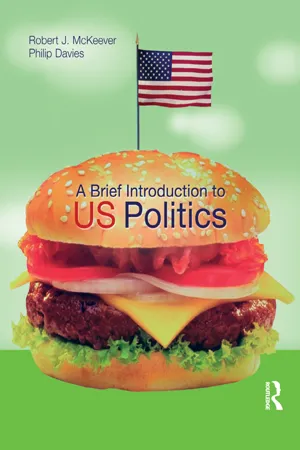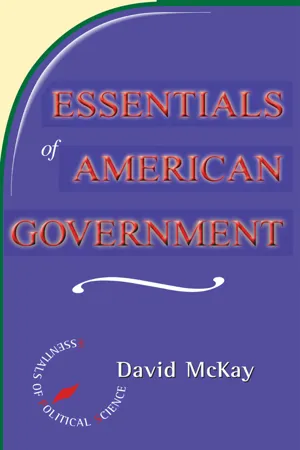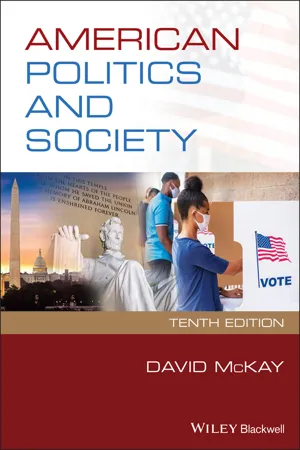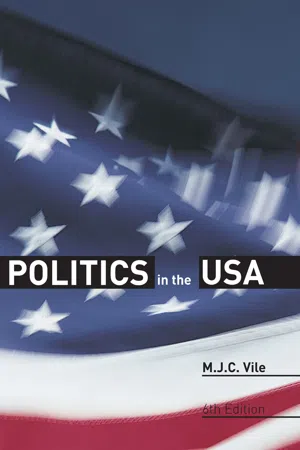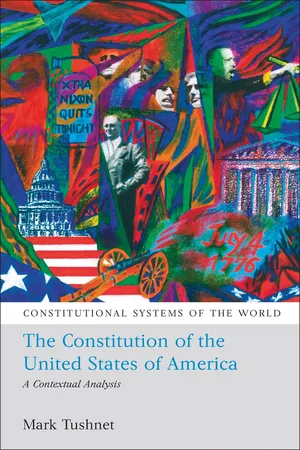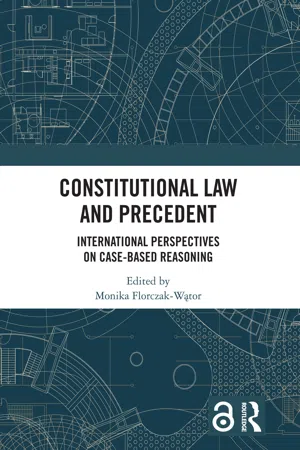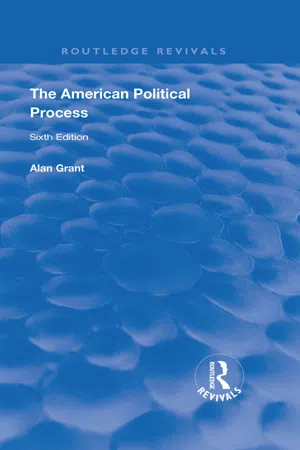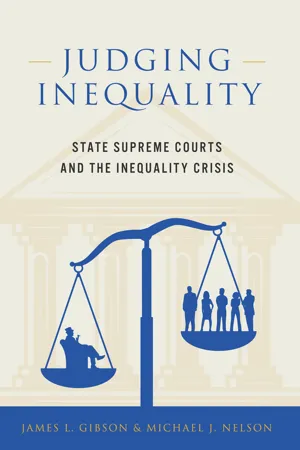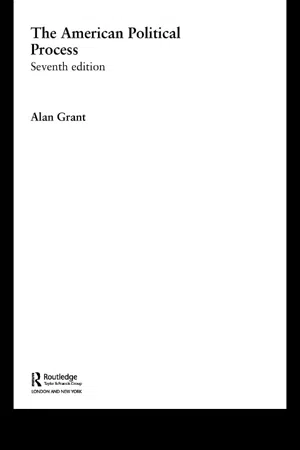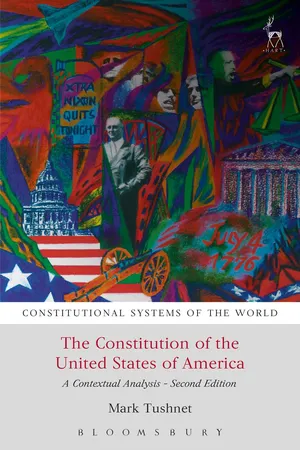Politics & International Relations
Supreme Court
The Supreme Court is the highest judicial body in the United States, responsible for interpreting the Constitution and federal laws. Comprised of nine justices who serve for life, the Court has the power to review and overturn decisions made by lower courts. Its rulings have a profound impact on American society, shaping laws and policies on a wide range of issues.
Written by Perlego with AI-assistance
Related key terms
11 Key excerpts on "Supreme Court"
- eBook - ePub
- Robert J. Mckeever(Author)
- 2014(Publication Date)
- Routledge(Publisher)
Chapter 8 The Supreme Court and judicial politics‘We are under a Constitution, but the Constitution is what the judges say it is.’ So said Charles Evan Hughes, politician and jurist, and later to become chief justice of the United States Supreme Court. His perceptive remark succinctly identifies the vital connection between the American political system and the American judiciary. The Supreme Court is the ultimate interpreter of the Constitution and that means it has a profound impact upon politics as well as upon law. In this chapter we will examine how a court of law became a powerful political body and why judicial power is important but controversial in contemporary American politics.Judicial reviewThe foundation of the Supreme Court’s legal and political power is the American version of the doctrine of judicial review. This empowers the Court to declare any law or action of a governmental institution – whether federal state or local – to be unconstitutional. This entails a majority of the nine justices deciding that a challenged law or administrative action violates one or more clauses of the Constitution.A second form of judicial review involves statutory interpretation. This is where the Court decides whether a state or local government measure violates a federal law. In both constitutional interpretation and statutory interpretation, the outcome is the same: if the Supreme Court believes a violation exists, then the inferior law is declared null and void.There is, however, a crucial difference between constitutional interpretation and statutory interpretation. If the Supreme Court interprets a federal statute in a way that offends Congress, then the legislators can simply amend the law to nullify the Court’s decision. If, on the other hand, a Court decision is based upon constitutional interpretation, then Congress has no power to overturn it. True, it can initiate the process of constitutional amendment, but this is extremely difficult to bring to a successful conclusion. In virtually all cases, then, a decision of the Supreme Court based upon constitutional interpretation is final, unless the Court can be persuaded to change its mind. - eBook - ePub
- David Mckay(Author)
- 2018(Publication Date)
- Routledge(Publisher)
12The Supreme Court and Judicial PoliticsWe are very quiet there but it is the quiet of a storm center.—Oliver Wendell Holmes, Associate Justice of the Supreme Court, 1902–1932In a democracy, politics is a process of popular education—the task of adjusting the conflicting interests of diverse groups,… and thereby the hostility and suspicion and ignorance engendered by group interests… toward mutual understanding.—Felix Frankfurter, Associate Justice of the Supreme Court, 1939–1962In all societies, the courts play some political role. In liberal democracies where the independence of the judiciary is regarded as essential to prevent the exercise of irresponsible executive (and sometimes legislative) power, the political role of the courts as interpreters of the law and as defenders of individual freedoms is well established. In despotic and one-party states, courts are political in the quite different sense that they are the instruments of a dominant executive.However, there are also important distinctions within liberal democratic states, the most crucial being the presence or absence of judicial review. As was noted in Chapter 3 , judicial review is long established in the United States, and the Supreme Court is the final arbiter of the meaning of the Constitution. Hence, all laws passed by the state and national legislatures, together with all executive actions, are subject to review by the courts, which judge their compatibility with the Constitution. As the final court of appeal, therefore, the Supreme Court has the legal power to declare any action by any other branch of government unconstitutional.This apparently formidable power is tempered by a number of factors, but in contrast to many other liberal democracies, the United States has a system that entails enormous potential judicial power. In the United Kingdom, for example, the courts can review executive actions—but only by testing them in relation to the content of acts of Parliament. This can produce sharp rebukes for governments when the courts judge that the government has acted ultra vires (beyond its powers), and the British courts are becoming more active in reviewing executive actions. A British Parliament controlled by the executive can, however, always reverse a judicial judgment, as sovereignty lies not in the Constitution but in Parliament. In the United States, a decision of the Supreme Court involving the constitutionality of a statute or governmental action can be overturned only by constitutional amendment (or by the Court itself, of course), and as was shown in Chapter 3 - eBook - ePub
- David McKay(Author)
- 2021(Publication Date)
- Wiley-Blackwell(Publisher)
CHAPTER 15 THE Supreme Court AND JUDICIAL POLITICSOutline- The American Legal System
- The Supreme Court:Decision-Making
- The Supreme Court and Political Power
- Controversy 15.1. The Supreme Court: An Active or a Passive Role?
- Briefing 15.1. The Supreme Court and the Guantánamo Bay Detainees
- The Polarized Rehnquist and Roberts Courts
- Conclusions: The Court and American Democracy
- Summary
- Questions for Discussion
- Glossary
- Notes
- Further Reading
We are very quiet there but it is the quiet of a storm centre.–OLIVER WENDELL HOLMES, ASSOCIATE JUSTICE OF THE Supreme Court, 1902–1932In a democracy, politics is a process of popular education – the task of adjusting the conflicting interests of diverse groups … and thereby to the hostility and suspicion and ignorance engendered by group interests … toward mutual understanding.– FELIX FRANKFURTER, ASSOCIATE JUSTICE OF THE Supreme Court, 1939–62In all societies, the courts play some political role. In liberal democracies, where the independence of the judiciary is regarded as essential to prevent the exercise of irresponsible executive (and sometimes legislative) power, the political role of the courts as interpreters of the law and as defenders of individual freedoms is well established. In despotic and one-party states, courts are political in the quite different sense that they are the instruments of a dominant executive. However, there are also important distinctions within liberal democratic states, the most crucial being the presence or absence of judicial review. As noted in Chapter 4 , judicial review is long established in the United States, the Supreme Court being the final arbiter of the meaning of the Constitution. Hence, all laws passed by the state and national legislatures, together with all executive actions, are subject to review by the courts, which judge their compatibility with the Constitution. As the final court of appeal, therefore, the Supreme Court has the legal power to declare any action by any other branch of government as unconstitutional. As we develop below, this apparently formidable power is tempered by a number of factors, but in contrast to many other liberal democracies, there can be no disputing the evidence of what is enormous potential judicial power. In the United Kingdom, for example, the courts can review executive actions – but only by testing them in relation to the content of Acts of Parliament. This can produce sharp rebukes for governments when the courts judge that the government has acted ultra vires or beyond its powers, and the British courts are becoming more active in reviewing executive actions. A British parliament controlled by the executive can, however, always reverse a judicial judgement, as sovereignty lies not in a constitution but in parliament (although, at least until 2020, in some matters the European Court of Justice did have the final say). In the United States, a decision of the Supreme Court involving the constitutionality of a statute or governmental action can be overturned only by constitutional amendment (or by the Court itself, of course) and, as shown in Chapter 3 - eBook - ePub
- David McKay(Author)
- 2017(Publication Date)
- Wiley-Blackwell(Publisher)
Chapter 15 The Supreme Court And Judicial PoliticsOutline
- The American Legal System
- The Supreme Court: Decision-Making
- The Supreme Court and Political Power
- Controversy 13. The Supreme Court: An Active or a Passive Role?
- Briefing: The Supreme Court and the Guantánamo Bay Detainees
- The Polarized Rehnquist and Roberts Courts
- Conclusions: The Court and American Democracy
- Summary
- Questions for Discussion
- Glossary
- Notes
- Further Reading
We are very quiet there but it is the quiet of a storm centre.– OLIVER WENDELL HOLMES, ASSOCIATE JUSTICE OF THE Supreme Court, 1902–32In a democracy, politics is a process of popular education – the task of adjusting the conflicting interests of diverse groups … and thereby to the hostility and suspicion and ignorance engendered by group interests … toward mutual understanding.– FELIX FRANKFURTER, ASSOCIATE JUSTICE OF THE Supreme Court, 1939–62In all societies, the courts play some political role. In liberal democracies, where the independence of the judiciary is regarded as essential to prevent the exercise of irresponsible executive (and sometimes legislative) power, the political role of the courts as interpreters of the law and as defenders of individual freedoms is well established. In despotic and one-party states, courts are political in the quite different sense that they are the instruments of a dominant executive. However, there are also important distinctions within liberal democratic states, the most crucial being the presence or absence of judicial review. As noted in chapter 4, judicial review is long established in the United States, the Supreme Court being the final arbiter of the meaning of the Constitution. Hence, all laws passed by the state and national legislatures, together with all executive actions, are subject to review by the courts, which judge their compatibility with the Constitution. As the final court of appeal, therefore, the Supreme Court has the legal power to declare any action by any other branch of government as unconstitutional. As we develop below, this apparently formidable power is tempered by a number of factors, but in contrast to many other liberal democracies, there can be no disputing the evidence of what is enormous potential judicial power. In the United Kingdom, for example, the courts can review executive actions – but only by testing them in relation to the content of Acts of Parliament. This can produce sharp rebukes for governments when the courts judge that the government has acted ultra vires - eBook - ePub
- M.J.C. Vile(Author)
- 2008(Publication Date)
- Routledge(Publisher)
10 Politics and the judiciaryIt may seem strange to link the description of the structure and functions of the judicial system with the further elaboration of the working of American politics; but in fact no proper understanding of the political system can be attained without a clear realisation of the role of the judges, and in particular of the justices of the Supreme Court of the United States, in the way in which policies are made and implemented. Politics, in the broadest sense, has an impact at all levels of the American judicial system, and equally the courts play a vitally important part in the way in which the government of the country is carried on. This is not to suggest that judges are necessarily politically motivated, in a narrow partisan sense, in coming to decisions. A large section of the American judiciary, certainly most federal judges, are of an extremely high calibre, but they cannot escape the responsibility of making decisions which in most countries are usually taken by the legislature or by executive officials. Some of the most significant decisions in American political history have been taken not by president or Congress, but by the Supreme Court, acting in its judicial capacity to settle disputes arising under the laws and Constitution of the United States. The extent of this power, the way in which it is exercised, the motivations and opinions of the men who exercise it, and its results for the American polity, are all factors that the political scientist must attempt to assess.The Supreme Court and judicial review
The Constitution of the United States briefly sets out certain broad, and rather vague, principles for the organisation and operation of government. It set up three branches of the government: a legislature, a chief executive and a judiciary; it recognised a division of power between federal and state governments and set out broad categories of federal power; it guaranteed certain rights to the individual, and set certain limits to the exercise of power by the federal and state governments. These rules still stand today, hardly altered at all in formal terms, yet applying to a country that has changed dramatically since 1787. However, these rules by their very nature are virtually meaningless without interpretation. What is the exact meaning of ‘No person shall be … deprived of life, liberty or property, without due process of law’, a provision of the Fifth Amendment to the Constitution adopted as part of the Bill of Rights in 1791? What exactly is entailed by ‘due process of law’? Or take the Commerce Clause of the Constitution, which gives to Congress the power ‘to regulate commerce with foreign nations, and among the several States, and with the Indian Tribes’. What exactly is ‘commerce’? Does it include the manufacture of goods or simply trading in the finished products; does commerce include ships, trains and aeroplanes, banks, insurance companies and atomic energy plants? The problems are endless. Who then should decide what the Constitution means and then apply that interpretation to specific cases? The Constitution makes no direct reference to this problem other than the provision of Article III that ‘the judicial power shall extend to all cases, in law and equity, arising under this Constitution, the laws of the United States, and treaties made, or which shall be made, under their authority.’ However, in the Federal Convention in Philadelphia in 1787 and in contemporary writing there is evidence that the members of the Convention were aware that the Supreme Court would have the power to interpret the Constitution and to declare null and void congressional acts that conflicted with the Constitution. Alexander Hamilton, in number 78 of the Federalist Papers - eBook - ePub
The Constitution of the United States of America
A Contextual Analysis
- Mark Tushnet(Author)
- 2008(Publication Date)
- Hart Publishing(Publisher)
4
The Constitutional Politics of the Judicial Branch
The US Supreme Court is at the top of a hierarchically organized, though somewhat complex, judicial system. There are two sub-systems of courts: one in the states and the other for the national government.1 The courts in the national judicial system are usually called the federal courts. State courts and the lower level federal courts have trial-level courts and appellate courts.2 Most American courts are generalist courts, with jurisdiction over claims of any sort.3 The US Supreme Court, on which this chapter focuses, has discretionary authority to hear appeals from decisions on matters of national law—statutory as well as constitutional—by the appellate courts in the national court system and by the highest state court authorized to decide the question of national law. Usually, but not always, that court is the state’s Supreme Court: in one notable case the US Supreme Court heard an appeal from a decision by the Police Court of the city of Louisville, Kentucky, which had imposed a small fine on the defendant, because under state law there were no appeals from such courts when small fines were imposed.4 - eBook - ePub
Constitutional Law and Precedent
International Perspectives on Case-Based Reasoning
- Monika Florczak-Wątor, Monika Florczak-Wątor(Authors)
- 2022(Publication Date)
- Routledge(Publisher)
100 in most cases the Court confirmed the finality of its decisions. The significant position of its precedents does not mean that the justices are continuously overturning federal and state legislation, or modifying the meaning of the supreme law of the land. The unique character of this institution and its jurisprudence lies in its potential to determine almost all matters concerning legal, political, social, or economic relations which are written in, or which can be derived from, the Constitution. The use of judicial review, founded in the early years of American statehood and actively exercised since the 1920s, has resulted in strengthening the position of the SCOTUS relative to the other branches of government, especially in the process of constitutional adjudication, making the Court a serious and often final interpreter of what the law means.There are definitely numerous factors determining justices’ reasoning in constitutional cases, and the research results presented in this chapter are not exhaustive, especially in the context of the means of constitutional interpretation imposed by the Court in history. Still, it seems obvious that SCOTUS precedents play a significant role in constitutional law, both as the source of rulings which explain the scope of governmental powers and the rights of the people, and as the body of common law responsible for understanding the character and principles of the American legal system. In constitutional cases the justices usually focus on the Court’s own prior rulings, referring not only to the holding of the precedent, but also to the arguments raised by their predecessors. They often use national courts’ decisions as a basis on which to inform, explain, and justify the conclusion they reach, whereas references to international law and international jurisprudence are still an exception, proving the atmosphere of distrust between American judges and their counterparts from international tribunals. Although in history there were decisions in which the justices quoted foreign law as one of the references in building their arguments, rarely have foreign legislation or foreign court decisions become an important source of reference in SCOTUS reasoning. The Atkins, Roper, and, especially, Lawrence - eBook - ePub
- Alan Grant(Author)
- 2019(Publication Date)
- Routledge(Publisher)
However, the Court is limited in a number of important ways. It does depend in the main on the executive branch to enforce the law it has interpreted. The Court can also only wait and react to cases that are brought into the judicial system. Unlike the President and Congress, the Supreme Court cannot, by itself, initiate policy making. Therefore the Court may find itself dealing with such matters as family or lifestyle issues because cases on these matters are brought before them and they are too significant to be refused judgement. This may be so, even at a time when the conservative majority tries to disclaim such an intrusive role in everyday life. 26 Finally, the Justices are aware that they are appointed to their positions and must use their powers sparingly, so that wherever possible direct confrontation is avoided with the democratically elected branches of government. The judges are part of the society within which they are working and they are subject to many of the same influences and prejudices as elected politicians, but the Court’s high standing with the public would be threatened if it resisted for long periods clear trends in public opinion. The Court’s friends and enemies depend upon the nature of its decisions at any one time; it has been attacked in turn by conservative and liberal politicians. Its decisions have often been controversial and it has been in the centre of the political arena precisely because the questions it examines are in important areas of vital interest to society and democracy. Professor Archibald Cox explains why the Court has managed to command general support for its judgements as follows: The Court must know us better than we know ourselves... the roots of its decisions must already be in the nation - eBook - ePub
Judging Inequality
State Supreme Courts and the Inequality Crisis
- James L. Gibson, Michael J. Nelson(Authors)
- 2021(Publication Date)
- Russell Sage Foundation(Publisher)
This may be because courts are not assumed to be important policymakers, or because the type of law courts make (mainly common law precedents) is deemed to be a poor cousin to statutory law. Neither assumption, however, is correct. Because the U.S. Supreme Court has steadily withdrawn from American politics (deciding far fewer than one hundred cases per year, a minority of which deal with state law), the state high courts have become the courts of last resort on a vast array of public policies. Indeed, as has been recognized by interest groups that try to shape the state judiciaries, these institutions are incredibly powerful and efficacious policymakers. 3 And creating judicial precedents is just as valuable to interest groups as getting laws passed through legislation. The list of policy areas in which state Supreme Courts have become major policymakers mirrors the list of the most pressing policies confronted by the other branches of state governments. And because each state has its own unique constitution, which often contains provisions dealing directly with inequality, the state judicial branch’s final say on the meaning of the state constitution makes it impossible to overstate the role these courts play in producing public policies relevant to the political, legal, economic, and social equality of Americans. Examples of the prominent role of state courts in shaping social and economic policy are easy to find. For instance, many state high courts have ruled on the legality of school funding equalization schemes (shifting tax revenue from wealthy school districts to poorer school districts). In other cases, state Supreme Courts have set guidelines for the conditions under which employers can dismiss employees without cause (“employment at will” doctrine) - eBook - ePub
- Alan Grant(Author)
- 2003(Publication Date)
- Routledge(Publisher)
The Supreme Court’s involvement in the downfall of President Nixon is an impressive illustration of its role in the American political system. It acted as the highest court of appeal to determine what the Constitution and the law meant when the ruling of a lower court was challenged. It was involved in the process of law adjudication, and its role as the final arbiter of the Constitution is essential as parts of the written document are ambiguous and require interpretation. In this particular case, the doctrine of ‘executive privilege’ is not even mentioned specifically in the Constitution, and the Supreme Court had to decide whether the independence of the executive branch, implied by the separation of powers principle, extended to an absolute privilege of confidentiality of presidential communications.The compliance by the President with the Supreme Court’s decision on the release of the subpoenaed tapes demonstrated the unique position which the Court had achieved. The executive and legislative branches of government accept the decisions of the Supreme Court even though it has no direct way of enforcing its decisions on the other institutions. The Court has consistently found support in the popular belief that the judiciary stands apart from the elected institutions and defends the fundamental law of the Constitution, and the level of respect and confidence in the Court’s integrity has been an important factor in this development.The Nixon case confirmed once again the importance of the separation of powers doctrine and the role of an independent judicial branch in preventing an arbitrary abuse of power by the executive authority. The Supreme Court’s decision effectively led to the resignation of a President who had lost the confidence of the people, but it was the culmination of a number of searching investigations by the judicial system. The District Court of John Sirica in Washington DC played a particularly crucial role in revealing the extent of the Watergate affair, and the lengthy legal procedures that went on for a couple of years after the original break-in showed the tenacity and effectiveness of the judicial process. The independence of the Supreme Court was also demonstrated by the fact that three of the eight justices who voted against the President in the case (Justice Rehnquist played no part in the discussions) were, in fact, appointed by Richard Nixon himself. - eBook - ePub
The Constitution of the United States of America
A Contextual Analysis
- Mark Tushnet(Author)
- 2015(Publication Date)
- Hart Publishing(Publisher)
The oldest constitutional court in the world, the US Supreme Court has become an important participant in the nation’s overall system of government. Important, but not dominant. Many political matters raise no constitutional questions. The Court’s justiciability doctrines keep some, though few, questions out of court. The mechanisms by which the courts are coordinated with the political branches mean that the courts’ independent contribution to governance is smaller than the rhetoric of judicial independence suggests. When political circumstances are configured ‘correctly’, the Supreme Court can play a large role in governance, although the coordination mechanisms mean that its role gradually, and sometimes not so gradually, diminishes.FURTHER READING
1American Judicature Society, ‘Methods of Judicial Selection’, available at http://www.judicialselection.us/judicial_selection/methods/index.cfm?state= (describing judicial selection methods in the states).Chemerinsky, E, Federal Jurisdiction (5th edn New York, Aspen Publishers, 2007) (containing a comprehensive discussion of the justiciability doctrine).Friedman, B, The Will of the People: How Public Opinion Has Influenced the Supreme Court and Shaped the Meaning of the Constitution (New York, Farrar, Straus & Giroux, 2009).Goldman, S, Picking Federal Judges: Lower Court Selection from Roosevelt through Reagan (New Haven, Yale University Press, 1997).Kramer, LD, The People Themselves: Popular Constitutionalism and Judicial Review (New York, Oxford University Press, 2003) (an account of the history of departmentalism, with the author describing his preferred version as ‘popular constitutionalism’).Snowiss, S, Judicial Review and the Law of the Constitution (New Haven, Yale University Press, 1990) (describing the early uses of departmentalism).
Index pages curate the most relevant extracts from our library of academic textbooks. They’ve been created using an in-house natural language model (NLM), each adding context and meaning to key research topics.
